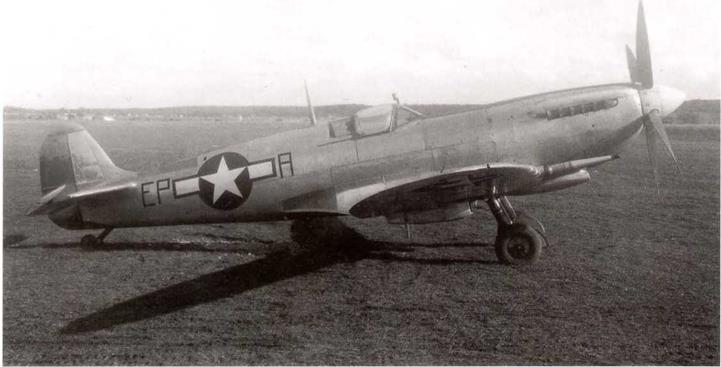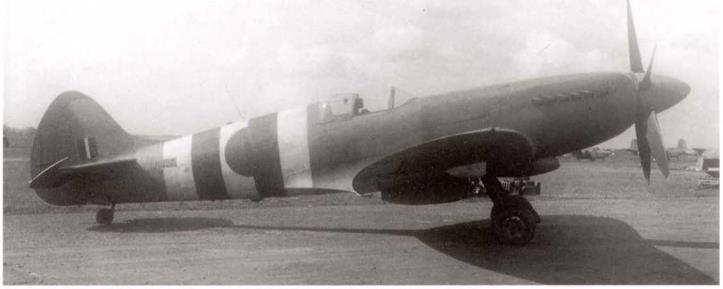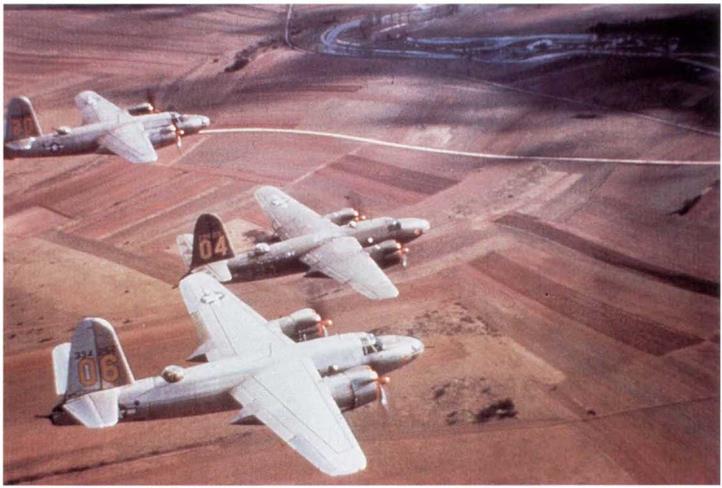Stripping Procedure
1, Thoroughly agitate the remover. Using a round bristle brush 6 to 8 inches in diameter with a 6-foot handle, apply a generous coating of the remover to areas being stripped. The remover should not be applied to surfaces which have water on them as water will stop the solvent action. It is best to strip the aircraft in sections, cleaning each section completely before going on to the next. The following order is recommended:
a. Tail section and fuselage aft of the trailing edge of the wing, including the empennage and tail cone.
|
Consolidated B-24J-180-CO, 44-40852, waiting for the next mission at Kunming, China, on September 6,1944. All aircraft are in natural finish except for one lone B-24E, with blue paint over the original red outline insignia. (IJSAF) |
|
Supermarine Spitfire Mk. IXc, aircraft EP-A, serial unknown. Seen at strip A-64, St. Dizier, France, on October 2, 1944. This aircraft was the personal property of Lt. Col. E. P. Allen, asst. A-З of ХГХ Tactical Air Command, Ninth Air Force. It was rumored at the strip that the Col. had traded a P-47 to the RAF for the Spitfire. (William L. Swisher) |
b. Upper surfaces of the fuselage in the area of the wing and the complete fuselage and nose section forward of the leading edge of the wings.
c. Individual wings, upper and lower surfaces,, including the nacelles.
d. Remaining lower surfaces of the fuselage and miscellaneous removed parts such as the anti-drag rings.
2. After the first coat of remover has remained on the surface from 15 minutes to 1 hour, apply a second coat. In applying the stripper and in washing it off with water, use care to prevent excessive contact of the stripper with the masking material which is effective only as a protection against splashing and contact with small quantities of stripper. The stripper should not remain on the masking paper longer than 30 minutes without being washed off with water.
|
Consolidated B-24J-I-FO, 42-50613, named "Holy Joe”, was aircraft “A” of the 34th BG, 93rd CBW, 3rd Air Div. In natural metal, the front outer portion of its vertical tails were red. This is another of the 93rd CBW groups that converted to B-17s in August 1944 (it is obvious from the date of these photographs that the B-24s saw action longer in these groups than the official history states.) Seen at strip A-64 on October 2,1944. (William L. Swisher) |
|
Supermarine Spitfire Pk Mk. XIX, RM635, aircraft Y of RAF 541 Sq., from Benson, England. It is seen at strip A-64 on October 2, 1944, still carrying the complete invasion stripes around the fuselage. This, despite the order removing them in July. Aircraft is finished in PRC Blue. (William L. Swisher) |
3, After the second coat of remover has remained on the surface from 15 to 30 minutes, scrub the wet surface thoroughly (using the same round bristle brush ) to loosen the finish that may not be entirely free of the metal. If the finish will not loosen, apply another coat of remover, allow to stand, and scrub again. The resistance to the remover of primed and camouflaged surfaces differs according to the initial finishing material used and the service the painted surface has had. The number of applications of remover and the scrubbing necessary to loosen the finish may best be determined by trial.
4. When the finish has thoroughly loosened, remove the finish beginning on the top surfaces, using a bristle brush push broom and water spray. A satisfactory water spray may be obtained by using a garden hose with the nozzle adjusted to a fine spray. The spray should give a generous amount of water at low or medium pressure and should be directed into the push broom which
|
Consolidated B-24J-CO, serial unknown, aircraft V2-B+ of the 855th BS, 491st BG, 14th CBW, of the 2nd Air Div. Seen at strip A-64 on October 3,1944. It is in natural metal finish. The vertical tail markings are incorrect for the unit; they should be a black stripe sloping forward. Those on the aircraft appear to have a white horizontal stripe on black background (that would be in markings for the 445tb BG of ihc 2nd CBW; the left hand fin appears to have suffered some damage, so possibly this is a quick-fix). (William L. Swisher) |
|
Piper L-4H-PI, 43-30245, aircraft 28-Z named “Judy”, of an unknown unit seen at A-64 on October 7, 1944. Note the narrow width invasion stripes carried by all field liaison aircraft at Gen. Bradley’s request. (William L. Swisher) |
should be about 18 or 20 inches wide. Do not apply water to the remover until loosening is complete, since water stops the solvent action of the remover.
When the surface has been thoroughly scrubbed, increase the pressure and volume of the water and thoroughly rinse the surface. Final Clean-up
1, Remove the masking material and clean the areas underneath by carefully applying remover with a paint brush. After the finish has softened, remove the major portion with Plexiglas, fiber, or hard rubber scrapers.
2. Prepare a mixture of approximately 3 parts of water with 1 part of ethyl acetate or 1 part of dope and lacquer thinner. Wash the entire stripped surface with soft, clean rags dipped in the mixture. Follow immediately by wiping dry with clean cloths. Best
|
Douglas A-20B-DL, 41-3380, of the 369th BS, 306th BG, 40th CBW, 1st Air Div, Eighth Air Force. Seen at strip A-64 on Octobers, 1944, this is a B-17 squadron “hack" that has had its camouflage stripped. Note the new “WW” letters above this serial number, denoting a war-weary aircraft. (William L. Swisher) |
|
|
North American P-51D-5-NA, 4-4-13396, aircraft GQ-G “One Long Hop”, of the 355th FS, 354th FG, seen at strip A-64 on October 8,1944. Note how the invasion stripes have been painted out with olive drab both above and below. The spinner is blue and checks on the nose are white and yellow. (William L. Swisher)
|
|
Martin B-26G-5-MA, 43-34258, in natural metal Finish, is yellow 06 of the 441st BS, 320lh BG, Italy. The lead aircraft is in Dark Olive Drab and Neutral Gray. All aircraft have red cowls and propeller bosses, Second natural metal aircraft is yellow 04 and the other is yellow 20. All are in the 441st BS. (USAF via Gerry R. Markgraf)
|
Bristol Beaufighter Mk. Vl-F, V8884, aircraft no.84 of the 415 Night Fighter Sq. seen at strip Y-99, Dijon, Long-Vic, France, on October 26, 1944. This unit was assigned to XII ТЛС, which had been used in operation DRAGOON on August 15, 1944. The unit had become part of the Ninth Air Force after the two forces had joined in France on September 15,1944. (William L. Swisher) |
results are obtained when the final wiping operation is accomplished while the surface is wet with the mixture of water and thinner.
3. Blow out all seams on the wing, empennage, and fuselage. Clean out any stripper which may have run down inside the fuselage. Check the inside of the fuselage to be sure that none of the fluid has run through the seams onto vital parts.
4. Wipe up any miscellaneous deposits of remover on unpainted areas with rags dipped in the water-thinner mixture.




















